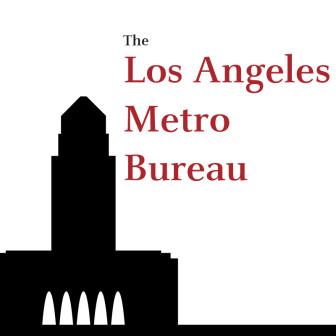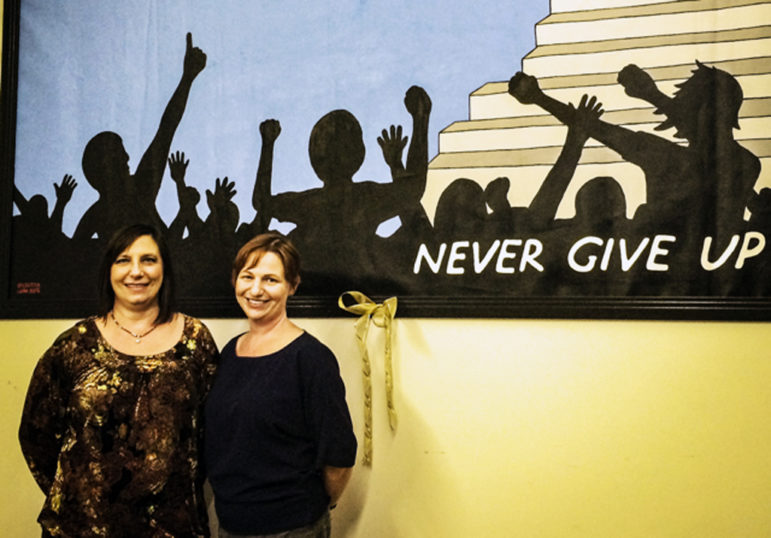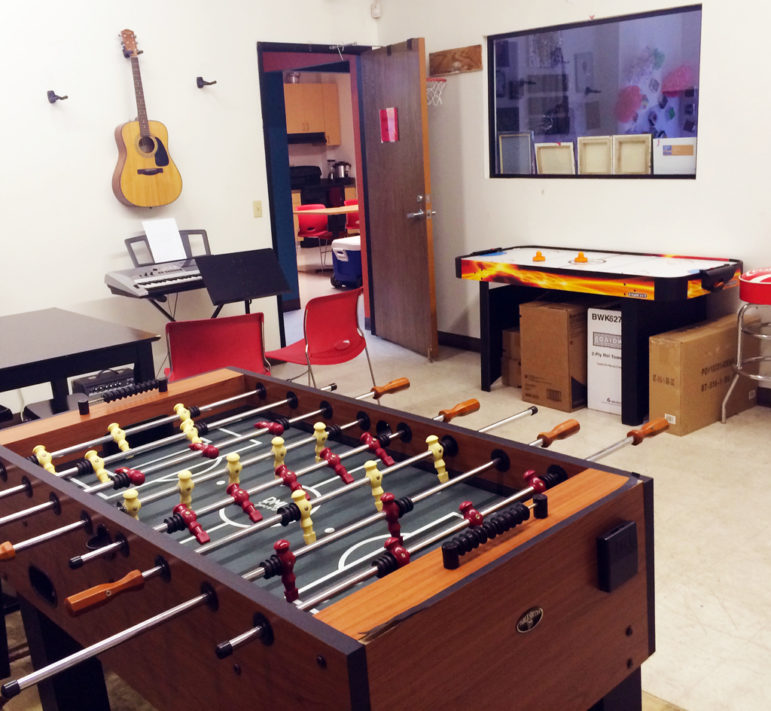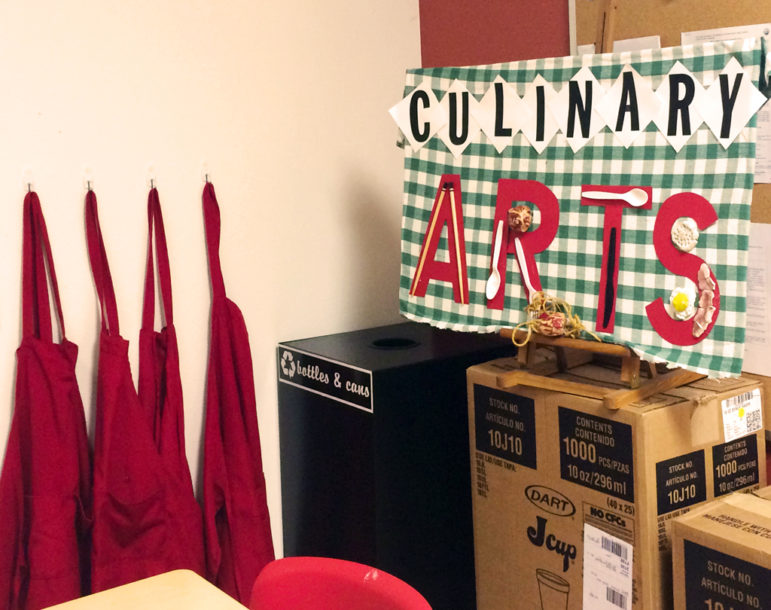
Photos by Sara Tiano
Manuel Dircio (left) and Jesus Vasquez, both 20, are star alumni of the Youthful Offender Wraparound program in Orange County, California.
LOS ANGELES — Manuel Dircio, 20, a business administration student at Fullerton College boasts a 4.0 GPA.
He is also a recovering alcoholic with a history of arrest and incarceration in juvenile detention — not quite what you’d expect from a seemingly model college student with a stellar grade point.
Dircio credits the Youthful Offender Wraparound program (YOW), which he says “helped [him] grow successfully.” It’s what’s known as a full-service partnership (FSP) in Orange County, California, that uses a nontraditional approach to help kids identified as having “complex needs.”
 Dircio was a dual status youth, meaning he had been been under the supervision of both the county’s child welfare system and the juvenile justice system. Dual status or “crossover youth” have higher rates of detention and recidivism than other justice system-involved youth. They are also statistically more likely to develop substantial behavioral health needs, according to a 2014 report from the Robert F. Kennedy National Resource Center for Juvenile Justice.
Dircio was a dual status youth, meaning he had been been under the supervision of both the county’s child welfare system and the juvenile justice system. Dual status or “crossover youth” have higher rates of detention and recidivism than other justice system-involved youth. They are also statistically more likely to develop substantial behavioral health needs, according to a 2014 report from the Robert F. Kennedy National Resource Center for Juvenile Justice.
Knowing his situation, Dircio’s probation officer referred him to the YOW program. The referral enabled YOW to get in touch with Dircio while he was still locked up in Orange County’s juvenile hall. Then 18, he had been in a group home in the foster care system for two years after being under his older brother’s guardianship from age 9.
“It was a disaster,” Dircio said of his life prior to enrolling in YOW and getting sober. “It was horrible. I was drinking, smoking drugs, not going to school, not having a job.”
The fact that Dircio turned 18 while incarcerated meant he’d aged out of the foster care system. Thus, he would have nowhere to go once released. The fact that he had been struggling with alcohol and drugs — and getting into legal trouble for it — made this worse. When YOW entered the picture, they paid for Dircio to move into a private sober living treatment center.

Hether Benjamin, director of youth development (left), and YOW Program Director Amy Sutherland say unconventional thinking and interagency collaboration are keys to YOW's success.
After moving into that facility’s stable environment, he started working on recovery from substance abuse and eventually found a job on his own. Though it wasn’t his first attempt at sobriety, this time it stuck.
“I tried alone, and I failed miserably,” he said with a self-deprecating laugh. “Once I decided to actually start accepting the help, and accepting advice from positive people, that’s when I started making that change.” Now he works while keeping up his grades, and sometimes does outreach with YOW for kids with difficult family circumstances who are starting to get into trouble as he did.
For more information about community-based alternatives, go to JJIE Resource Hub | Community-Based Alternatives
Dircio’s success story is a prime example of what YOW was designed to accomplish: promoting the positive development of juvenile justice-involved youth who struggle with mental health diagnoses, substance use disorders and histories of trauma by providing supports to manage these challenges.
“Why we’re here is to look at the underlying reasons why they are participating in the delinquent and criminal behaviors,” said Hether Benjamin, director of youth development for Community Service Programs (CSP), the nonprofit that operates YOW.
Orange County’s FSPs are intensive treatment programs that coordinate a unique menu of mental health services for each client to address individualized needs. YOW is one of 12 programs run by CSP that incorporate shelter services, crime victim assistance, youth development programs, comprehensive support for at-risk youth, conflict resolution and community education programs.
Once enrolled, YOW clients have access to an array of positive, proactive services that may seem unconventional, but are all aimed at addressing the causal mental health issues at play.

YOW's game and rec rooms add appeal to the guidance center, and also provide a space for clients to have informal, lower-pressure therapy sessions with their counselors, Hether Benjamin says.
Air hockey, yoga and cooking classes
YOW is available to 16- to 25-year-old Orange County residents who have both a mental health diagnosis and a history with the county’s juvenile justice system. It provides traditional individual, family and group therapy, along with substance abuse treatment and anger management. In addition, YOW offers skill-building opportunities, like computer tutorials, career and education guidance, as well as job interview outfits.
The atmosphere inside YOW’s Fountain Valley strip-mall guidance center is a lot warmer than the formal listing of its services might suggest. There youths have access to a couple of game rooms with air hockey and ping pong, access to art supplies and musical instruments, culinary arts classes and fitness classes, like yoga and jiujitsu.
According to YOW staff, this array of activities accomplishes two goals: creating a safe, healthy space where the kids actually want to spend time, and using unconventional techniques to provide services without the kids necessarily even knowing they’re getting help.
“Everything we do is tied into alleviating the symptoms that led to the behavior that got them incarcerated,” Benjamin said.
Even the rec rooms serve a double purpose at YOW, according to Benjamin. They’re crucial to creating the nonthreatening, living room environment the administration hopes to achieve, while also serving as informal therapy rooms.
When clients are having a bad day and can’t sit through a therapy session, Benjamin explained, they’ll come talk with staff over foosball and have the counseling session without realizing it. YOW offers laundry facilities that clients can sign up to use — and often they wind up chatting with their coordinator on the couch while they wait for their clothes.
The idea is that the more relaxed, enjoyable atmosphere will make the treatment more organic and accessible, in contrast to the conventional “therapeutic dose” of 50 minutes per week with a clinician. The center---which is open Monday to Friday from 8:30 a.m. to 5 p.m.---is designed to encourage clients to drop in anytime the need or whim strikes, rather than just during scheduled appointments.
“Having those quick interactions of ‘Hey, how’s it going,’ or ‘Hey, do you want to go get something to eat’ ... those are what I think makes the biggest difference,” said YOW Program Director Amy Sutherland. It is also what differentiates the program “from traditional therapy,”
Jesus Vasquez, another YOW alumnus, said this kind of daily support, even hourly, if needed, was pivotal to his recovery process. He described himself as an outcast in his own family and said the only time he ever got attention was when he would get arrested. Before enrolling in YOW, Vasquez said he “didn’t know where to turn” when he had bad days.
“They were always there for me, every single person. They always had something positive to say,” Vasquez, 21, said of the guidance center staff. “If it was my old friends they’d tell me, ‘Come on, man, you need a drink,’ and that’s what I don’t need anymore.”
‘They never gave up on us’
What further differentiates YOW from other juvenile diversion models, according to Vasquez and other YOW graduates, is that the positive support system didn’t disappear or punish him when he had a setback in his recovery process, he said. Vasquez told about the time he showed up at the guidance center one morning after having gotten into trouble the night before, sobbing because he thought he’d forfeited all the progress he’d worked so hard to make.
Instead — according to Sutherland, who was part of the crisis intervention team that morning — nearly half a dozen staff members rallied around Vasquez, telling him, “OK, let’s problem solve. What needs to be done?”
Vasquez was briefly reincarcerated due to his bad night. “But he knew we weren’t going to go anywhere in that time,” Benjamin added. “We visited him, continued our treatment plan with him, in custody.”
Clients who return to YOW after getting into trouble again are welcomed with open arms and lots of encouragement, Benjamin said.
It’s a sign that they had a good enough experience the first time to reach back out and try again, agreed Sutherland. Some clients need to return two or three times.
“If they relapse, go back into incarceration, well then, it wasn’t this time — it’s the next time. We get excited that they call again,” Benjamin explained. It’s all about resiliency, building on strengths and creating positive reframes around struggles past and present, she said.

Services such as culinary arts classes serve as life skills training, job skills training and a form of art therapy, according to Amy Sutherland.
And the strategy works. According to CSP, YOW and the organization’s other youth development programs have succeeded in reducing recidivism: Clients exhibit, on average, a 75 percent decrease in episodes of incarceration, as well as a 91 percent decrease in days homeless and a 94 percent decrease in episodes of psychiatric hospitalization compared to their lives before joining the program.
YOW started in 1972 as a collaborative study with the University of California, Irvine’s social ecology department to divert youth who were going to juvenile hall for minor offenses such as curfew violations. YOW serves an average of 250 clients each year.
What it takes to say ‘whatever it takes’
YOW’s often-invoked motto is “Whatever it takes,” which means several things in the YOW playbook. It refers both to a policy of flexibility in treatment options, and a promise of an individualized, adaptive service plan. It also gives the message to the clients of what Benjamin and other staff call “sovereignty.”
YOW’s clients are both “partners and consumers” in their treatment plan, Benjamin said. “They have just as much say as the county of Orange does, as the probation officer does. Because it’s their life.”
Sutherland says giving the patients power in their treatment goes a long way in making them more receptive. The people in YOW have “been dictated to for so long,” she said, and they shut down when they start being told what to do. YOW coordinators “work alongside” the clients, allowing them to focus on the issues they want to address, in the way they want to address them, ultimately working toward the goals they want to achieve.
“If they’re having a horrible time managing their mood and they can stabilize that by running on a treadmill, doing a punching bag, we will pay for a gym membership. There’s a mental health need for that service,” Benjamin said. “Tattoo removal. If those tattoos are preventing them from having self-esteem, good body image, getting a job, being looked at seriously by other peers, we will help them remove those tattoos if that’s what they want.”
Vasquez is among the clients who have benefited from this particular offering.
Flexible programs through flexible funding
YOW is able to provide their level of specialized service via flexible funds designated for individualized services and supports. Funding originates through the mental health services 1 percent tax on California residents earning $1 million or more annually. The money is distributed through county governments. In Orange County, the OC Mental Health Care Agency “takes those dollars and specializes it down to these really underserved populations,” Sutherland said.
That a program like this is being funded with mental health dollars is noteworthy, according to Melissa Sickmund, director of the National Center for Juvenile Justice, a nonprofit juvenile justice research group. There’s been a “big push” for systems integration, in which the juvenile justice, child welfare, mental health and education departments share information and resources, she said.
According to Sickmund, systems integration represents a hopeful path to more flexible funding of rehabilitative services for youthful offenders. “Part of the juvenile justice reforms that are happening would encourage that kind of a thing,” she said. There’s currently no statewide protocol for systems integration in California, but some counties have enacted their own protocol for how the courts should work with dual status minors, Orange County among them.
Sutherland said YOW’s adaptable funding system is a big part of what differentiates it from many full-service partnerships that provide each client with the same menu of services. It provides for truly individualized treatment plans, in keeping with a fundamental tenet of the wraparound theory, and it lets administrators empower clients with more choices in their own treatment, she said. It also allows the program to go to extreme lengths when needed, such as temporarily paying for a bed in sober living to avoid a kid becoming homeless, as they did with Dircio.
Yet, it’s not necessarily the speciality services that keep Dircio connected to the program and coming back to help post-graduation — it’s Adrian Grow, who helped him enroll in Fullerton College; it’s Christina Tompkins, who helped him get his driver’s license and secure a place to stay.
“That’s what I got out of this program the most — not financially, just the good support system they have,” Dircio said. The YOW staff was always there for him, and still is, he said, which is why he reciprocates by doing youth outreach with them — and talking to the press.
“Whenever they call me or need me I’m going to help them.”

A truly outstanding program that deserves widespread replication.
The interface between “growing human beings” — finding one’s individualized purpose, love of community, good citizenship, in sum, respect and affection for one another — and the seemingly unrelated topic of terrorism is real.
As the first increases, the second will have less and less power to tdraw to itself the youth of the world.